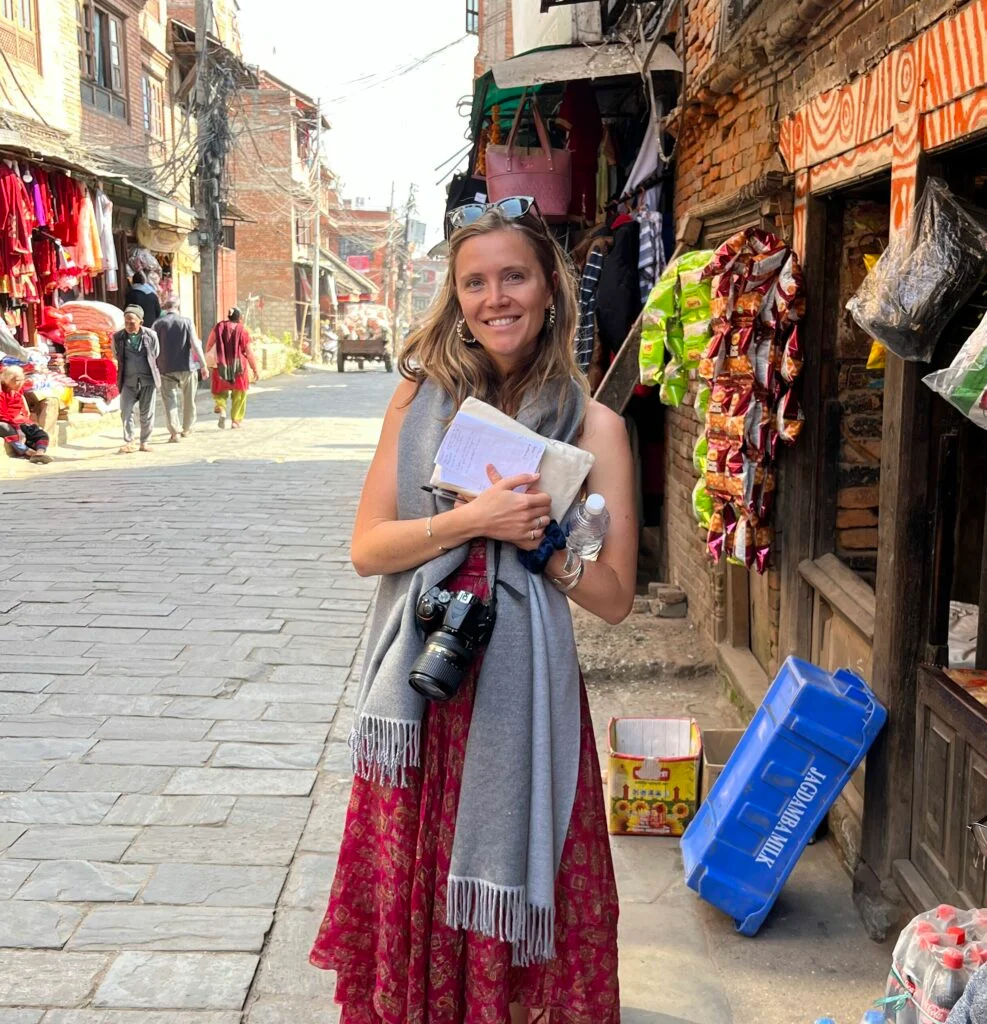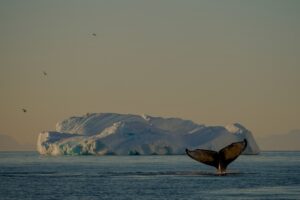
As trite as this may sound, I do think the Southern Continent is life changing. It’s an extraordinary place, somewhere you can’t necessarily describe until you’ve seen it for yourself.
Renowned as the most inhospitable place on earth – the highest, widest, driest, coldest, windiest continent on earth, and yet, the most dramatic, beautiful, interesting, magical, breath-taking continent on earth too. It’s simply incomprehensible to compute how Shackleton and his men managed to survive nearly five months grounded on Elephant Island in the winter months. When we visited the site, the fog crept in, which totally enhanced the ghostly atmosphere Elephant Island inhabits. It’s definitely not somewhere any of us wanted to get stuck on, and we tried to visualise being stuck there, but in reality that was almost impossible as we were just onlookers from the comfort of our exceptional vessel, far removed from the grim reality of Shackleton’s open lifeboat.

THE DRAKE PASSAGE
The perils of the infamous Drake Passage crossing might deter some from visiting Antarctica. And indeed, you’re forever grateful to your captain, in our case surely one of the most skilled boatman ever to sail the Southern Ocean. You also form a strange bond with the newly improved stabilisers, which limit the amount of rocking and rolling that can happen. Maybe I was just lucky as I took no sea sickness pills and felt absolutely fine, and we certainly did have some rocky and rollie nights! My theory – eat and drink normally, and you’re away. It’s all in the head.
Our Captain, Oleg, and his Expedition team were on watch all night as we navigated the disloyal seas, keeping a careful eye out for tabular icebergs. Evening briefings on board would reveal what the weather was planning to spring upon us and just our luck…massive storms were building throughout the entire voyage. Yet somehow, through meticulous planning and years of experience, Captain Oleg and his team were largely able to evade them, taking shelter when necessary in undiscovered bays. We even had a few days of bright sunshine, much to our surprise.
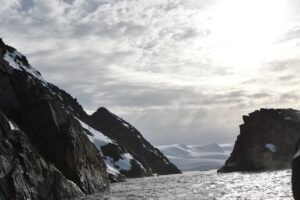
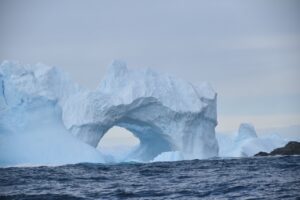
A little selfish of me perhaps, but I relished the fact that, unlike many of the larger ships, we avoided holing up for several days while one of the bigger storms passed through. However, this did remind us that we were very much on an expedition and not a cruise – the weather is so unpredictable that itineraries have to change without notice and be entirely flexible. As such, it’s a real ‘go with the flow’ adventure and you’ll need to be prepared for early morning ‘reveilles’ to explore neighbouring bays or glaciers, even earlier if there’s a pod of orca in attendance outside your porthole.
Some also worry about cabin fever on close-knit expeditions of this kind. But you quickly adapt to your surroundings, to the extraordinary sensation of complete isolation, and there is so much to do and to absorb (as well as to eat – the food is unlimited!). You’re forever up and down the stairs, out on deck, spotting marine animals and birds – albatross are a particularly magnificent sight in full glorious flight), attending lectures on all things Antarctic, heading down to the mudroom for a zodiac outing, or simply running to the tea station to grab yet another peanut butter cookie. It is never ever boring.
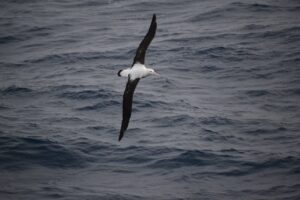
And the views…indescribably wild, spectacular and unpredictable as the weather. Shafts of light penetrate the clouds to hit the peaks, glaciers and icebergs and the whole landscape changes in front of your eyes. I just hope my pictures here do it some justice.
Certain incredible moments stand out from a sea of others. Out on the water – blustering winds, rain hammering down, and quite a swell running. From nowhere a humpback whale appears and dances around our zodiac again and again, its pectoral fin within feet of capsizing the boat but somehow taking care not to soak us. A very cool moment.
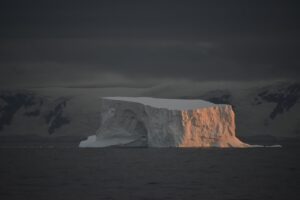

Certain incredible moments stand out from a sea of others. Out on the water – blustering winds, rain hammering down, and quite a swell running. From nowhere a humpback whale appears and dances around our zodiac again and again, its pectoral fin within feet of capsizing the boat but somehow taking care not to soak us. A very cool moment.
Another whale encounter, again out on the water, but this time with the sun beating down and the sea glass-like. We were heading towards some nearby icebergs where thousands of Adelie penguins had gathered, only to be encased suddenly by a pod of fifteen humpback whales feeding on the krill that thrives in these nutrient-rich waters. As the whales surfaced to breathe, they were close enough for us to smell the krill. A rare and extraordinary sight, one that our guide had never experienced before and one that we all found intensely moving.
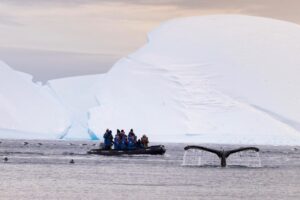
SOUTH GEORGIA
An oasis of stunning natural beauty 100 miles long by 20 miles wide and absolutely teeming with marine life. In one bay alone, we saw four different species of penguin, two different types of seal and innumerable bird species, including the endemic South Georgia pipit framed by a gorgeous backdrop of lush tussock grasses. Oh, and three blue whales just to cap it all.
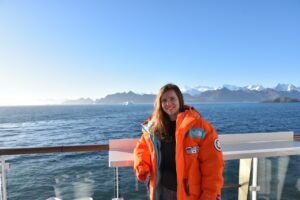
We made landfall here in South Georgia at Cape Disappointment after two hard days of sailing. Captain James Cook had dubbed it so when he discovered that South Georgia was merely an island and not another continent. We on the other hand were delighted to see the island’s formidable snow-covered mountains appear on the horizon and to set foot on land again in such a remote and magical spot.
South Georgia was known primarily for its whaling industry, until the practice was finally banned in 1965. All the same, it was still a fascinating experience to visit Grytviken where all the whale oil was stored in colossal cylindrical containers and to learn something of those days. We also stopped off at the Post Office to send cards home. The next service was not for months, and the cards have yet to arrive, but the fun is in the waiting!


THE FALKLANDS
The Falkland Islands could be mistaken for a Scottish isle in the Outer Hebrides – swathes of moorland ringed by white sandy beaches and aquamarine seas. ‘Miles and miles of bugger all’ as Sir Denis Thatcher infamously described it, but there’s a difference here in the Falklands – penguins, surely the most lovable and captivating of all God’s creatures.
There are also the battlefields of the 1982 war with Argentina. Arriving into Port Stanley, we were met by a fleet of Land Rover Defenders (typically British, there’s even a Waitrose in town) for a tour through the mountains where the main battles were fought in desperately inhospitable and difficult terrain. Although some 40 years ago now, the rawness and tension can still be felt; indeed, when one of our party tried to pay for something in pesos, she was told in no uncertain terms that “we only use peso as loo roll” by the local Falklander shopkeeper!

As for the penguins, avian flu may have sadly reached these remote sub-Antarctic islands, and as a result we were unable to complete one of our scheduled landings, but there were several bays where colonies appeared to be largely unaffected and we were able to walk among them and enjoy the infectious thrill of interacting with these wonderful birds. Biosecurity and environmental protocol have always been a vital ingredient of any polar expedition, but never more so than now and our footwear was carefully washed with disinfectant before transferring from zodiac to ship after every shore excursion. And tweezering out grass seeds from the Velcro on our waterproof trousers became almost routine.


Antarctica’s fragility only serves to heighten the experience, and the memories I brought home with me will last a lifetime. If you ever get the chance, then grasp it with both hands. It’s just too special to miss.
